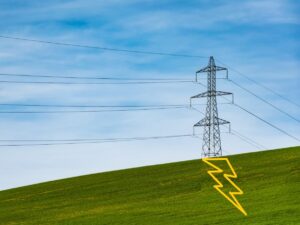Welcome to the Healthy Indoor Consultants Blog.
Resources, recommendations, and articles to help you create the most pure indoor environments in your life.
Issues with Ground Current
Issues with Ground Current

I asked ChatGPT to write something on the rather boring subject of Issues with Ground Currents in comical style. This what they created! Give it a read, because it is actually true!
Ground currents, those mischievous little rascals of the electrical world, always find a way to surprise us. They flow through the ground like rebellious underground rivers, seeking adventures in the unlikeliest of places.
They’re like the elusive spirits of electricity, tickling the toes of unsuspecting passersby and playing hide-and-seek with our equipment’s sensitive circuits,
by joining forces to throw a wild dance party in our audio systems, adding a funky beat to our favorite tunes—stray current DJ at its finest! Unfortunately, they can also play a part in impacting our health…
Ground currents refer to electrical currents that flow through the ground for various reasons. These currents are often undesirable and can lead to several issues in electrical and electronic systems as well as affecting our health. They can be detrimental to our health because ground currents can create potentially dangerous unwanted magnetic fields where we live or work.
Elevated AC magnetic fields have been associated with:
- Depressed levels of neuro-hormones, serotonin, and dopamine
• Behavior changes
• Elevated serum triglyceride levels
• Altered circadian rhythm
• Release of noradrenaline within 15 minutes
• Exposure during gestation contributes to learning difficulties
• Prolonged exposure can result in single and double DNA strand breaks, leukemia, lymphoma, and brain cancer - • Dogs living in homes with elevated magnetic fields are six times more likely to develop lymphoma
If you want to go deep and geek out, continue reading….
There are two main types of ground currents:
- Intentional Ground Currents: These are currents deliberately introduced into the ground for specific purposes, such as:
- Grounding Systems: In electrical systems, a grounding conductor is used to connect the electrical ground to the earth, providing a safe path for fault currents to dissipate and ensuring the system’s stability.
- Grounding Electrodes: Grounding electrodes, such as ground rods or plates, are installed to enhance the effectiveness of grounding systems.
- Earth Grounding in Electronics: Many electronic devices have a grounding pin in their power plugs to connect to the earth ground for safety and noise reduction purposes.
- Unintentional Ground Currents (Stray Currents): These are unwanted currents that flow through the ground and give rise to imbalances in the electrical system, particularly in power distribution and transmission networks. These issues can affect us where we live. Here are some of the main issues associated with ground current:
- Electromagnetic fields (EMF): Ground currents generate magnetic fields around conductors and electrical systems. High levels of EMF can pose health risks to humans and may interfere with nearby sensitive equipment or electronic devices.
- Stray voltage: Ground currents can lead to the presence of stray voltage in unexpected places, such as the surfaces of fences, gates, and other grounded objects. Stray voltage can be hazardous to humans and animals, especially in agricultural settings where livestock may come into contact with electrified structures.
- Neutral-to-ground voltage: Ground current flowing through the neutral conductor in a power distribution system can lead to neutral-to-ground voltage. This voltage can cause undesirable effects in electrical systems, such as voltage fluctuations, malfunctioning of electronic devices, and even electric shocks to users.
- Ground potential rise (GPR): When a fault occurs in a power system, a significant amount of fault current may flow through the grounding system, causing a voltage rise at the grounding points. This phenomenon is known as ground potential rise (GPR). High GPR can lead to potential differences between different grounding points, posing safety risks and equipment damage.
- Lightning-related issues: Ground currents induced by lightning strikes can cause severe damage to power distribution systems, including transmission lines, transformers, and other electrical equipment. It is essential to have proper grounding and surge protection measures to mitigate these effects.
- Equipment damage: Excessive ground current can cause damage to electrical equipment, such as transformers, generators, motors, and other sensitive electronic devices. The continuous flow of current through the earth can lead to electrolysis, corrosion, and heating effects in the conductive parts of the equipment, reducing their lifespan and efficiency.
- Interference and noise: Ground currents can induce interference in nearby communication lines, particularly in telecommunications and data transmission systems. This interference can manifest as noise, crosstalk, and signal degradation, leading to communication problems and reduced data transfer rates.
To address grounding issues,
Proper grounding and earthing practices are crucial in electrical systems. By ensuring low-resistance paths for ground currents and implementing adequate grounding measures, many of these problems can be minimized or eliminated.
It is essential to follow local electrical codes and standards to maintain safe and reliable electrical systems. If you live in a house, you might notice a wire next to the foundation, that runs from the meter (where your power company feeds electricity to your house) down into the earth.
This is your earth grounding wire that feeds your system ground (that 3rd pin on 3-prong electric cords) into the earth. The thickness of the wire is measured in AWG which stands for American Wire Gauge. A smaller AWG number means a thicker wire which can carry more current into the ground.
Using a Thicker Ground Wire: The National Electric Code (NEC Section 250-24(c)) recommends a minimum of 6 AWG or 4 AWG copper wire (depending on the maximum current for the residence (200 amps or 400 amps, etc.). However, a number of experts have recommended using a larger copper wire such as 1/0 AWG if practical (copper, stranded). If not practical, as large of a copper stranded AWG wire as possible.
Though using a larger grounding conductor than the minimum required by NEC will not necessarily cause any problems, it could result in increased material costs. However, under sizing the grounding conductor could be dangerous as it may not effectively carry fault currents, leading to safety hazards in the event of a fault.
DO NOT DO THIS YOURSELF! BE SURE TO USE A LICENENSED ELECTRICIAN TO UPGRADE YOUR HOUSE GROUNDING WIRE.

Click HERE to schedule a free mini-consult where I can hear your issues and offer a few tips.
Follow me on Facebook: